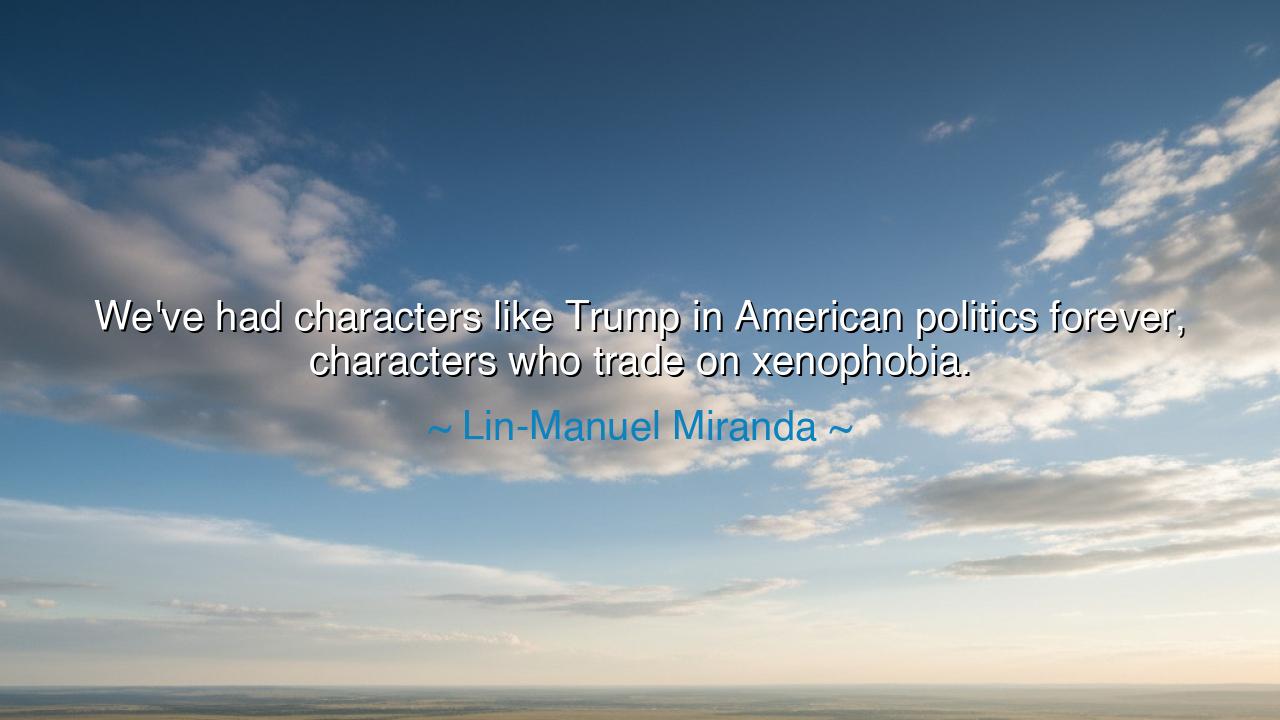
We've had characters like Trump in American politics forever
We've had characters like Trump in American politics forever, characters who trade on xenophobia.






The words of Lin-Manuel Miranda, “We’ve had characters like Trump in American politics forever, characters who trade on xenophobia,” are not merely an observation of the present but a reflection upon the deep currents of history. He reminds us that the figure who stirs fear of the foreigner, who builds power upon division and suspicion, is not new but ancient. Xenophobia has always been a weapon in the arsenal of ambition, a flame that can rouse the masses yet burn the bonds of community.
The ancients knew this truth as well. In Athens, leaders at times turned suspicion against outsiders, inflaming the people to preserve power. In Rome, politicians roused fear of barbarian tribes or rival nations to rally the populace, even when such fear was more useful to their ambitions than to the safety of the state. Miranda’s words echo this timeless warning: politics can be twisted when leaders choose not to guide with vision, but to manipulate with fear.
History offers many mirrors. In the late 19th and early 20th centuries, waves of immigrants to America met fierce xenophobia. Politicians exploited fears of the Irish, Italians, and later the Chinese, claiming they would undermine the nation’s culture or economy. Laws like the Chinese Exclusion Act arose not from justice, but from fear stoked for political gain. These episodes remind us that Trump is not the first, nor will he be the last, to wield this weapon; it is a recurring pattern, a shadow stretching across generations.
Miranda’s words, however, are not despair but a call to vigilance. If such characters have always existed, so too have voices of courage who stood against them. For every demagogue who fueled division, there were leaders who called for unity, who proclaimed that America’s strength lay not in fear of the outsider, but in the weaving together of many peoples. To recognize the old pattern is to be armed against it, to see clearly when fear is used as a tool of power.
Let the generations remember this: beware the leader who urges you to fear your neighbor, for he seeks not your safety but your submission. Xenophobia is an ancient snare, dressed in new garments for each age. But the true strength of a people lies not in exclusion, but in the courage to embrace diversity, to draw wisdom from many roots, and to stand together as one. For the demagogue fades, but unity, once forged, can outlast the ages.






TNcong tai Nguyen
From a policy design lens, I want levers that reduce the payoff of scapegoating. Could civic infrastructure blunt it—universal service programs that mix people from different backgrounds, community deliberation forums with facilitated contact, or small-donor public financing that widens candidate incentives? I’m also curious about schools: curriculum that teaches propaganda detection without partisan labels. Closed question: if a city can run one pilot next year, which has the highest expected return—contact-based dialogues, media literacy embedded in libraries, or campaign finance experiments that amplify broad participation?
MPDo Mai Phuong
Coming from an artist, I hear an invitation to counter fear with imaginative belonging. What cultural interventions move the needle beyond preaching to the choir—commissioned stories from mixed-status families, immersive exhibits that let audiences “switch places,” bilingual stages in swing counties? I’m interested in measures of impact that aren’t vanity metrics: changed local policies, cross-group alliances formed, durable audience diversity. Open question: what’s the most effective way for artists to partner with educators and organizers so performances translate into civic participation rather than a cathartic night out?
MQthanh minh que
The line comforts and alarms me. Comfort, because it reminds me democracies have weathered demagogues before. Alarm, because saying “we’ve seen this” can slide into complacency. What’s the right posture between vigilance and overreaction? How do we respond without amplifying the very messages we oppose—ignore, debunk, or outcompete with better stories? I’d love a rule of thumb for newsrooms and citizens: when does platforming expose tactics responsibly, and when does it feed the spectacle? Closed question: do blackout strategies ever work, or does sunlight paired with context consistently outperform?
QNDinh Quynh Nga
As a reader, I’m struck by the historical claim. If figures who lean on fear of outsiders recur, what conditions revive them—economic shocks, rapid demographic change, media incentives, or geopolitical insecurity? I’m curious how much is demand (voter anxiety) versus supply (entrepreneurs of outrage). Also, when the pattern returns, does it always follow the same script, or do new technologies mutate the playbook? Closed question: would you support a nonpartisan “rhetoric audit” during campaigns that flags dehumanizing frames in real time so citizens can evaluate appeals without banning them?